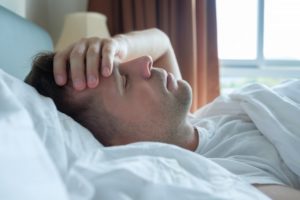 Many people – about one in 13 to be exact – are all too familiar with the feeling of waking up every morning to throbbing head pain. Your first thought might be that it’s a migraine, but there’s also a second, more dangerous possibility: sleep apnea in Las Vegas. In some cases, headaches are a side effect of an untreated sleep disorder that, if left untreated, could lead to any number of health problems. Do you want to stop your pain and enjoy a full night’s rest? Read on to learn how to recognize sleep apnea headaches and what you can do about them.
Many people – about one in 13 to be exact – are all too familiar with the feeling of waking up every morning to throbbing head pain. Your first thought might be that it’s a migraine, but there’s also a second, more dangerous possibility: sleep apnea in Las Vegas. In some cases, headaches are a side effect of an untreated sleep disorder that, if left untreated, could lead to any number of health problems. Do you want to stop your pain and enjoy a full night’s rest? Read on to learn how to recognize sleep apnea headaches and what you can do about them.
Why Does Sleep Apnea Cause Headaches?
During episodes of sleep apnea, your body stops breathing, trapping oxygen in your lungs. This usually occurs because relaxed muscles or tissues have relaxed and fallen back on the airway. Normally, the carbon dioxide your lungs produce is exhaled, but if you can’t breathe, the harmful substance will enter the blood stream instead. This causes the vessels around the head to dilate, which is the source of the headaches.
How Do You Know It’s Not a Migraine?
Migraines and sleep apnea headaches are often mistaken for one another (especially since both tend to be a recurring issue), but you can differentiate between them as long as you know the signs. A normal migraine typically affects one side of your head, but a sleep apnea headache causes pain on both sides. Furthermore, pain related to a sleep disorder will fade quickly after you wake up; migraines, on the other hand, might last for multiple days.
What Should You Do About a Sleep Apnea Headache?
By no means should you ignore your headaches if you think they’re linked to sleep apnea. Leaving the problem alone for too long could put you at risk for heart attacks and similar issues due to frequently suffering from a lack of oxygen. Having your sleep apnea treated will prevent these health problems – and of course, it should stop your headaches as well!
First you need to have the disorder diagnosed through a sleep study, which can be performed in a lab or at home. After that, a sleep dentist can create a treatment plan for you depending on your needs. This often involves an oral appliance that keeps the jaws positioned in a way that leaves the airway unobstructed; you might also need to use a CPAP machine that delivers air into your throat. Losing weight and changing your sleeping position can also help.
Sleep apnea headaches may not seem problematic at first, but if you want to enjoy a life free of pain and the complications of a sleep disorder, it’s always better to contact your sleep dentist sooner instead of later.
About the Author
As a member of the American Academy of Dental Sleep Medicine, Dr. Pamela West has been treating sleep apnea for over five years now and works alongside medical experts across Nevada to develop the best possible treatment protocol for each of her patients. She offers oral appliance therapy as well as other solutions for overcoming sleep-related breathing disorders. To schedule an appointment, visit her website or call (702) 602-2000.
